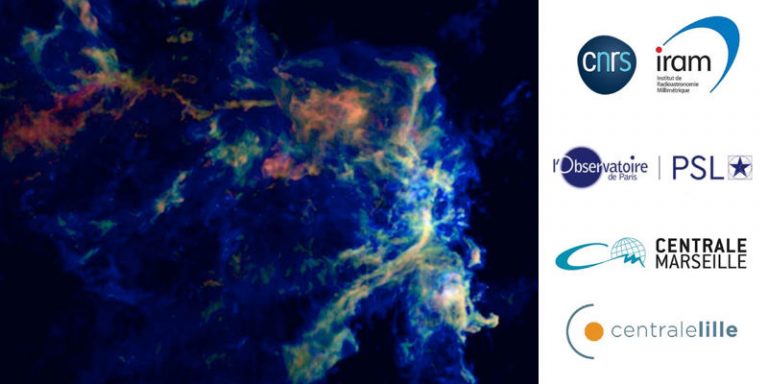
A team of scientists from CNRS, IRAM, Observatoire de Paris-PSL, and the schools Centrale Marseille and Centrale Lille gathered within the ORION-B program worked on improving the visibility of astrophysical phenomena hitherto inaccessible thanks to artificial intelligence. His work is the subject of a series of three articles published in Astronomy & Astrophysics onNovember 19, 2020. The researchers present the most complete observations of one of the regions of star formation closest to Earth.
Orion B, for Outstanding Radio-Imaging of OrioN B, is a programme in which scientists from the Laboratoire d’études du rayonnement et de la matière en astrophysique et atmosphères (Observatoire de Paris – PSL/CNRS/Sorbonne Université/Université de Cergy-Pontoise) and the Institut de radioastronomie millimétrique (IRAM) were involved, the Lille Centre for Research in Computer Science, Signals and Automation (CNRS/University of Lille/Centrale Lille), the Institute for Research in Astrophysics and Planetology (CNRS/University Toulouse III Paul Sabatier), the Toulouse Institute for Research in Computer Science (CNRS/Toulouse INP/University Toulouse III Paul Sabatier), the Fresnel Institute (CNRS/Aix-Marseille University/Centrale Marseille), the Bordeaux Astrophysics Laboratory (CNRS/University of Bordeaux), the Physics Laboratory of the Ecole Normale Supérieure (CNRS/ENS Paris/Sorbonne University/University of Paris) and the Grenoble Images Speech Automatic Signal Laboratory (CNRS/University Grenoble Alpes), Instituto de Física Fundamental (CSIC) (Spain), National Radio Astronomy Observatory (United States), Chalmers University (Sweden), Cardiff University (United Kingdom), Harvard University (United States), Universidad Pontificia Católica (Chile)
The gas clouds where stars are born and grow are vast regions of the Universe that are very rich in matter, and therefore in physical processes. Intertwined at different scales, times and sizes, all these processes make it almost impossible to fully understand the star nurseries. But scientists in the ORION-B program have just proved that statistics and artificial intelligence can remove the barriers that still stand in the way of astrophysicists.
With the goal of delivering the most detailed analysis to date of the Orion cloud, one of the regions where the closest stars to Earth form, the ORION-B team has integrated scientists specializing in massive data processing into its ranks. They have thus developed new methods based on statistical learning and machine learning to study observations of the cloud made at 240,000 frequencies of light. These observations were carried out on one of IRAM’s radio telescopes, the 30-metre antenna in the Sierra Nevada (Spain).
Based on artificial intelligence algorithms, these tools make it possible to discover new information in a large mass of data such as that of the ORION-B project. They have thus made it possible to unveil certain “laws” governing the Orion cloud.
Scientists have been able to uncover relationships between the light emitted by certain molecules and hitherto inaccessible information: their calculations make it possible to estimate the quantity of hydrogen or the quantity of free electrons in the cloud, without observing them directly. By analysing all the data at its disposal, the research team was also able to determine how to further improve its observations by eliminating certain “parasitic” information.
The ORION-B teams now wish to test this theoretical work in practice, by applying the estimates and recommendations established to verify them in real conditions. Another major theoretical challenge will be to extract information on the speed of movement of molecules and thus visualize the movements of matter to see how it moves within the cloud.
Bibliography
- Quantitative inference of the H2 column densities from 3mm molecular emission: A case study towards Orion B. Pierre Gratier, Jérôme Pety, Emeric Bron, Antoine Roueff, Jan H. Orkisz, Maryvonne Gerin, Victor de Souza Magalhaes, Mathilde Gaudel, Maxime Vono, Sébastien Bardeau, Jocelyn Chanussot, Pierre Chainais, Javier R. Goicoechea, Viviana V. Guzmán, Annie Hughes, Jouni Kainulainen, David Languignon, Jacques Le Bourlot, Franck Le Petit, François Levrier, Harvey Liszt, Nicolas Peretto, Evelyne Roueff, and Albrecht Sievers. A&A, November 19, 2020.
- Tracers of the ionization fraction in dense and translucent gas: I. Automated exploitation of massive astrochemical model grids. Emeric Bron, Evelyne Roueff, Maryvonne Gerin, Jérôme Pety, Pierre Gratier, Franck Le Petit, VivianaGuzman, Jan H. Orkisz, Victor de Souza Magalhaes, Mathilde Gaudel, Maxime Vono, Sébastien Bardeau, PierreChainais, Javier R.Goicoechea, Annie Hughes, Jouni Kainulainen, David Languignon, Jacques Le Bourlot, François Levrier, Harvey Liszt, Karin Öberg, Nicolas Peretto, Antoine Roueff and Albrecht Sievers. A&A, November 19, 2020.
- C18O, 13CO, and 12CO abundances and excitation temperatures in the Orion B molecular cloud: An analysis of the precision achievable when modeling spectral line within the Local Thermodynamic Equilibrium approximation. Antoine Roueff, Maryvonne Gerin, Pierre Gratier, François Levrier, Jérôme Pety, Mathilde Gaudel, Javier R.Goicoechea, Jan H. Orkisz, Victor de Souza Magalhaes, Maxime Vono, Sébastien Bardeau, Emeric Bron, Jocelyn Chanussot, Pierre Chainais, Viviana V. Guzman, Annie Hughes, Jouni Kainulainen, David Languignon, Jacques Le Bourlot, Franck Le Petit, Harvey S. Liszt, Antoine Marchal Marc-Antoine Miville-Deschênes, Nicolas Peretto, Evelyne Roueff and Albrecht Sievers. A&A, November 19, 2020.
Translated from Des scientifiques utilisent le machine learning pour rendre visible des phénomènes astrophysiques jusqu’ici inaccessibles









